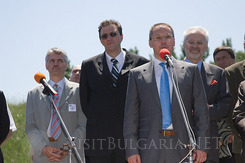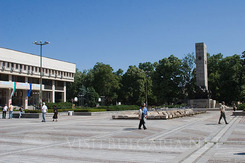Over one billion euro has been invested in the wellness and spa industry in Bulgaria over the past more...
| Search | Hotels / Accommodation | Vacations | Tours & Trips | Rent A Car | Transport | Flights | Conferences | Press Centre | Yachting |
- Hotels & Accommodation in Vidin



- Anna Kristina
- Avramov Hotel
- Dunav hotel
- Neptun Hotel
- The Old Town
- Vidin Hotel
- Nearby hotels



- Danubia Beach Hotel
- Vidin Guide
- Early booking in Vidin
- All inclusive in Vidin
- Last minute in Vidin
- Hotels in Vidin
- Apartments in Vidin
- Villas in Vidin
- Rural houses in Vidin
- Vacations in Vidin
- Transport To Vidin
- Tours in Vidin
- Conferences in Vidin
- Articles on Vidin
- News From Vidin
- Baba Vida Fortress
- Magura Cave
- The Rabisha lake
- Holidays in Bulgaria
- All inclusive
- Beach
- Birdwatching
- Golf
- Health
- History
- Hunting
- Monasteries/ Religious
- Mountain biking
- Prom
- Rural
- Ski
- Spa & Wellness
- Trekking
- Water sports
- Weekend breaks
- Wine
- Conference
- Children Holidays
- Yachting
- Events
- Type of accommodation
- Hotels
- Apartments
- Villas
- Rural houses
- Destinations
- Aheloy
- Ahtopol
- Albena
- Apriltsi
- Arbanassi
- Asparuhovo
- Assenovgrad
- Bachkovo Monastery
- Balchik
- Bankya
- Bansko
- Banya (Karlovo)
- Banya (Razlog)
- Batak
- Beklemeto
- Belchin Bani
- Beli Iskar
- Belogradchik
- Berkovitsa
- Blagoevgrad
- Bodrost
- Bojichen
- Borovets
- Botevgrad
- Bourgas
- Bozhentsi
- Bratsigovo
- Brestovitsa
- Buzludja
- Byala
- Chepelare
- Cherepish Monastery
- Chernomorets
- Chiflik
- Devin
- Dimitrovgrad
- Dobarsko
- Dobrich
- Dobrinishte
- Dolna Banya
- Dospat
- Dryanovo
- Dupnitsa
- Dyuni
- Elena
- Elenite
- Elhovo
- Gabrovo
- Gela
- Golden Sands
- Gorna Oryahovitsa
- Gotse Delchev
- Govedartsi
- Grand Hotel Varna
- Harmanli
- Haskovo
- Haskovo Mineral Baths
- Hissarya
- Ivaylovgrad
- Kalofer
- Kamchia
- Kamen Bryag
- Kardjali
- Karlovo
- Kavarna
- Kazanlak
- Kiten
- Kom
- Koprivshtitsa
- Kosharitsa
- Kostenets
- Kostenkovtsi
- Kotel
- Kovatchevitsa
- Kranevo
- Kresna
- Kulinoto
- Kyustendil
- Lom
- Lovech
- Lozenets
- Lukovit
- Lyaskovets
- Madara
- Malko Tarnovo
- Malyovitsa
- Melnik
- Mezdra
- Momchilovtsi
- Montana
- Narechen Baths
- Near Golden Sands
- Nessebar
- Obzor
- Ognyanovo
- Osogovo
- Pamporovo
- Panagyurishte
- Panichishte
- Parshevitsa
- Pavel Banya
- Pavlikeni
- Pazardjik
- Pernik
- Petrich
- Pirdop
- Pleven
- Pliska
- Plovdiv
- Pomorie
- Pravets
- Preslav
- Primorsko
- Ravda
- Razgrad
- Razlog
- Ribaritsa
- Rila Monastery
- Riviera
- Rousse
- Rusalka
- Samokov
- Sandanski
- Sapareva Banya
- Semkovo
- Sevlievo
- Shabla
- Shipka
- Shipkovo
- Shiroka Laka
- Shkorpilovtsi
- Shoumen
- Silistra
- Sinemorets
- Sliven
- Smolyan
- Sofia
- Sopot
- Sozopol
- Srebarna
- St. Constantine & Elena
- Stara Zagora
- Starozagorski Baths
- Sunny Beach
- Sunny Day
- Sveti Vlas
- Svilengrad
- Svishtov
- Targovishte
- Teteven
- Tran
- Trigrad
- Troyan
- Tryavna
- Tsarevo
- Tsigov Chark
- Uzana
- Varna
- Varshets
- Veliko Tarnovo
- Velingrad
- Vidin
- Vitosha
- Voneshta Voda
- Vratsa
- Vratsata Gorge
- Yagoda
- Yakoruda
- Yambol
- Zlatitsa
- Zlatograd
- Bulgaria Guide
- General information
- Bulgarian Monasteries
- SPA Bulgaria
- The Black sea
- History
- Geography
- Maps
- Weather
- Airports in Bulgaria
- Webcams
- Forums
- Mountains in Bulgaria
- The Balkan Mountain Range
- Rila Mountain
- Pirin Mountain
- The Rodope Mountain
- Vitosha Mountain
- Travel Arrangements
- Visit Bulgaria
- Visa Requierments
- Choose Destination
- Flights to Bulgaria
- Transport in Bulgaria
- Advice
- Currency
- Official Holidays
Subscribe to newsletters to receive our hottest offers:
| Home > Vidin > News |
Construction of Danube bridge 2 takes off
BNR, Milka Dimitrova, Radostin Zhelev

After a very serious delay of seven years the construction of a second bridge over the river Danube spanning the Bulgarian city of Vidin and the Romanian, Calafat, has finally been launched. The facility will be part of the European transport corridor number 4 acting as a bridge between Central Europe and the Thessalonica port on the Aegean Sea in Greece and also a pre-requisite for enhancing the economic ties not only in the region of the Balkans, but also along the entire stretch of the Pan-European Corridor number 4.
 Danube Bridge 2 will contribute to the integration of Bulgaria’s road and railway infrastructure into the European transportation network. The local economy in the region of Vidin will benefit millions of euro and nearly 1000 new jobs. The facility will be made of steel and concrete and will be 1971 m in length, and will have a single electrified railway track and two road lanes for traffic in two directions. The blue prints envisage also a pedestrian and biker’s alley 2 m in width. The bridge will rise 20 m above the level of the waters, which will not prevent the passing of the vessels underneath.
Danube Bridge 2 will contribute to the integration of Bulgaria’s road and railway infrastructure into the European transportation network. The local economy in the region of Vidin will benefit millions of euro and nearly 1000 new jobs. The facility will be made of steel and concrete and will be 1971 m in length, and will have a single electrified railway track and two road lanes for traffic in two directions. The blue prints envisage also a pedestrian and biker’s alley 2 m in width. The bridge will rise 20 m above the level of the waters, which will not prevent the passing of the vessels underneath.
Seven years ago, in February 2000, the Stability Pact launched the project for the construction of the bridge with a meeting in Brussels of Bulgarian and Romanian governmental delegations. Bodo Hombah, then coordinator of the Stability Pact initiated the meeting attended also by then Enlargement Commissioner Guenter Verheugen. The Bulgarian side presented statistical data and the results of research carried out by international experts on the effects of the construction of a second bridge over the river Danube linking Bulgaria and Romania. The Romanian side voiced concerns that the facility will take away a large portion of the traffic of the port of Constanta. Nevertheless, a month later the Bulgarian and Romanian governments signed an agreement specifying the technical and financial details of the facility’s actual construction. In 2002 a British-Spanish tie-in was chosen to carry out the consultancy work on the project’s engineering and management. At the end of 2006 ran the tender for the chief contractor and designer of the bridge, won by the Spanish FCC company. A contract for independent supervision of the construction work was signed with a French-British consortium. The latter will be responsible for the dynamic and static parameters of the facility’s body. On January 24, 2007 the Bulgarian parliament ratified the bilateral agreement for the construction of Danube bridge 2.
Prime Minister Sergei Stanishev broke symbolically ground in mid-May. According to the terms of the contracts with the Spanish company, the facility ought to be ready in 3 years’ time. The cost of the construction of the bridge and adjacent infrastructure has been estimated at € 236 million. The Stability Pact and the ISPA programme of the European Union will allocate € 70 million of the total cost. The European Investment Bank will provide another € 70 million. And € 20 will come via a grant of the German KFV crediting institution. The French Development Agency will earmark € 5 million. The Bulgarian state will provide co-funding to the tune of € 60 million. The construction of Danube Bridge 2 will contribute to regional development in the lands lying on both sides of the facility, Michael Humphreys, Head of the EC Representation in Bulgaria, pointed out. In his words it was essential that the construction of the facility was carried out in strict monitoring over the funds’ absorption, to avoid corruption practices.
The construction of a second bridge over the River Danube linking Bulgaria and Romania is in fact an excellent opportunity for revival in one of he country’s most underdeveloped regions, the Northwestern one. The facility is also the largest in scale infrastructure project ever carried out in that part of the country. It is supposed to expand the traffic along the axis Vidin – Greek border. It will in all likelihood bring life back to the settlements along its way and will create new jobs in a region notorious for its unemployment rate. Last but not least the venture will open good prospects before the tourist industry, which for the time being seems to be the only plausible occupation for the unemployed population.


















